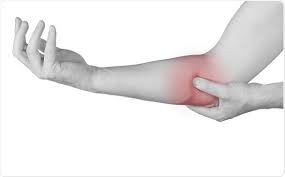Typical Ways to Treat Elbow TendonitisWhether you call it elbow tendonitis, golfer’s elbow, tennis elbow, or just elbow pain, it is all the same. The main difference is whether the pain is on the inside or outside of the elbow. Elbow tendonitis is a more general term, whereas golfer’s elbow refers to pain on the inside of the elbow, while tennis elbow is pain more to the outside of the elbow. The cause for each is a little different, but the solutions are very similar.
Golfer’s elbow, pain on the inside of the elbow, is caused by gripping objects too tightly. This can be a club, racquet, or bat. It can also be a steering wheel, computer keyboard, testing on a phone, or gripping an object and twisting it. The reason the pain is in the elbow from gripping something with your hand, is not so obvious. There are five muscles that attach to the inside of the elbow, run down the arm, and stop at the finger tips. When you close your hand to hold on to something, those muscles are engaged. The more force you place on your grip, the tighter the muscles become. Over time, this will lead to elbow pain and even carpal tunnel pain if left untreated.
Tennis elbow, pain on the outside of the elbow, is caused by gripping an object and pushing it away from you like a backhand swing in tennis. Like golfer’s elbow, gripping objects can lead to pain on the outside for the elbow as well. When you grip an object, you will contract the muscles on the inside of the forearm to hold as the muscles on the outside of the forearm contract to stabilize the arm.
Finally, the rotation of the arm requires the muscles between the 2 bones in the forearm to contract which adds additional pressure on the attachment sites at the elbow. Over time, this can feel like you are losing your grip because it becomes difficult to close your fingers, and there may even be pain in your hand. Some professionals may tell you it could be arthritis or muscle weakness.
Most people are told to use ice after they feel the pain. Ice will reduce the inflammation and pain, but it is only temporary. Ice is also a numbing agent which reduces the pain as well. The problem here is, it becomes to much work just to do a few things in your life. After a while, you may find yourself giving up on the activity you love to do.
Strength training to improve your grip. In some cases muscle weakness is the cause, but in most cases it is not. Gripping a tennis ball or anything to improve your grip may make it worse if strength is not your problem. For most people their forearms are hard and painful if you press on them. Sadly, few people realize this as the only forearms they get to feel are their own. This means whatever your arm feels like, is your normal. Finding a new normal with nothing to compare it to is difficult.
Arm bands have become very popular. You can get them many different colors and cool designs. They do help in the short-term, but long-term you may develop pain in other areas. The band restricts the movement of the forearm, which means the brain will find another way to do the same movement that caused your pain initially. Pain may move to the neck and shoulder or the wrist.
Pain pills and injections are popular way to stop the pain, and they will. However, the damage can become worse as you will continue to use the muscles while they are numb.
How Do You Solve the Pain?
The solution is easy but needs to be consistent. The only tools you need are your hands. Let’s say your right elbow is painful on the outside. Bend your right arm at the elbow, place your left hand on your right forearm with the thumb just below the elbow, then gently press down until you feel the edge of pain. As you press down, slowly rotate your right arm under your thumb. Once the pain subsides, work your way down your right arm to the wrist. I work on my forearms every day because I use my hands daily. I even do it sitting at a stoplight.
If the pain is on the inside of the elbow, we will work on the inside of the forearm. Using your right arm, extend it straight out. Take the left hand and grip under the right forearm with your left thumb just under the elbow. Gently press down with the left thumb as you rotate your right arm. Press just hard enough to get the edge of pain, breathe out, and allow the muscles to release. Slowly work down your arm to the wrist. It is the same treatment for both sides with the only exception being the arm is bent when working on the top of the forearm and straight when working on the bottom of the forearm.
Do these daily for just 5 minutes each side so you can solve your pain and continue to do the things you love. You should be able to easily feel the 2 bones in your forearm and have no pain.
What is Going on with My Book?
Not much has changed from my report from last week. We are still on track to complete the second re-write by March 1.


